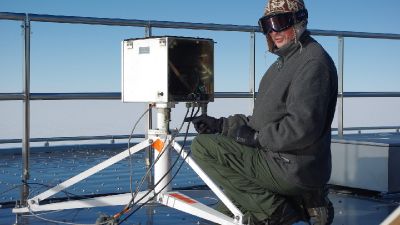
BELATMOS: Alexander Mangold on Measuring the Atmosphere
After he returned from his stay at the Princess Elisabeth Station (PEA) in February, we got in touch with Alexander Mangold from the Royal Meteorological Institute in Belgium. We discussed the progress made since last season and he shared his thoughts on his stay in Antarctica.
The aim of the BELATMOS project is to observe the composition and chemistry of the atmosphere at the Princess Elisabeth Station, with the particular aim of monitoring ozone and related trace gases, UV radiation and aerosol particles. Because few measurements of this type have been made thus far in Antarctica, various instruments need to be installed at the PEA in order to improve our understanding of how aerosols and trace gases are transported over long distances to Antarctica.
When asked about his major achievements for the 2010-2011 season, Alexander mentioned the installation of four new instruments, with all of them functioning in the extreme conditions in Antarctica until the end of the season. "It is also worth mentioning", he said, "that the sunphotometer (which measures the total extinction (attenuation) of sunlight by atmospheric aerosol particles at several wavelengths) delivered almost 48 days’ worth of observations, which is outstanding given the limited good observations days in Antarctica." Along the same lines, the ozone spectrophotometer (which measures the incoming sun radiations in the UV-A and UV-B bands as well as the total thickness of the atmospheric ozone column) delivered around three weeks’ worth of quality data to the international database.
The instruments that were installed this season are the aethalometer and the TEOM-FDMS. Both do aerosol characterization and provide important optical and physical characteristics of the atmosphere. The other two instruments, the ozone spectrophotometer and the sunphotometer, have been working well to date. For the coming seasons, Alexander says, the aim will be to monitor the state of the instruments and install an additional four to the array in Utsteinen, bringing the total number of instruments to eight.
Conducting research in Antarctica is crucial for Alexander Mangold and the BELATMOS project, as it is the only place on Earth where scientists can take the background measurements needed to evaluate changes in concentrations and better understand the long-range transport of aerosols and trace gases. These are closely related to climate change through a variety of feedback mechanisms that either weaken or strengthen its effects. The collected data can eventually help validate satellite data and simulations of global aerosols and trace gas models, climate models, or weather forecast models. Once validated, this data will also be fed into international databases for scientists all over the world to use over different fields of study.
"The project", the researcher further explains, also "helps monitoring the recovery of the ozone layer, which is the Earth’s natural barrier against hazardous UV radiation". The measurements, he says, will help improve and validate various models, which make for more accurate simulations.
The BELATMOS project is financed by the Belgian Federal State and aims to determine, measure, and characterise the composition of the atmosphere in Antarctica, in the area where the PEA station is located. According to Alexander, this location is interesting because the station is not located on the coast, but 200km further inland, which allows the BELATMOS scientists to fill an observational gap in the data collected in Antarctica.
"The plus point of the Princess Elisabeth Station when compared to other Antarctic stations”, Mangold says, referring to the PEA's zero-emission status, "is that it doesn’t influence the background concentrations there." On a more personal note, he added that scientists and everyone visiting Antarctica should protect the place and therefore leave as little trace as possible of their passage on the continent. "If we can prove that the station is running", the scientist concludes, "also to develop good scientific results, including winter data, the message will be passed on to other communities that this kind of science and operation of an Antarctic station is possible with a very low impact on nature."
Picture: Alexander Mangold at the Princess Elisabeth Station - © International Polar Foundation - René Robert
